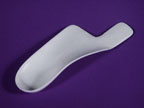Rigid Morton’s Extension

Rigid Morton’s Extension (RME) is a continuation of the orthosis shell/module beyond the first metatarsophalangeal joint (MPJ), extending the shell material distal of a conventional trim shape behind the met head to under the joint, past the hallux Interphalangeal (IP) Joint, and sometimes to the tip of the toe.
In cases of turf toe, hallux rigidus, hallux limitus with severe dorsal 1st MPJ pain secondary to dorsiflexion, this rigid extension can aid in limiting first MPJ motion that may result in pain. It is a particularly effective component in limiting 1st MPJ dorsiflexion.
The application of a Rigid Morton’s Extension may be used for a temporary splint while the patient’s condition heals and may be removed (ground off) once the joint has returned to functioning pain free within normal range of motion. One bi-product of applying a RME is functionally it serves as a gait extension to cause in-toe. Meaning, it promotes STJ supination through terminal stance, as the foot will invert when it rockers away from the rigid material under the 1st toe.
The standard trim length for a RME from Biomnechanical Services is distal of the IP joint but proximal of the end of the great toe. Shoe fit must be considered when extending it distal to the toe. In order to trim the distal end to fit when fully extended under the toe, a tracing of the inlay out of the patient’s shoe will solve for most fitting discrepancies.Rigid Full Length Foot Plate:
An alternate application of a full-length rigid graphite plate/inlay inside the shoe is often considered in the above mentioned pathologies. Rigid foot plates not only limit dorsiflexion at the 1st MPJ, they extend the lever arm beyond all the toes. It’s not unusual for a patient to externally rotate their limb during terminal stance or develop a frontal plane shift somewhere in the locomotor linkage system to get over the extended lever arm, either anomaly being a compensatory maneuver that can contribute to pathological disruptions in gait. And I think Dr. Dannenberg would agree, any mechanism that promotes a shortened stride can lead to pronounced gait and posture adaptations.
An orthosis can be put on top of this plate. This combination of orthosis and plate should not be bonded together as the extended forefoot lever arm would inhanced, causing the heel area of the orthosis to pull away from the patient’s heel, especially during sport activities. The rigid plate by itself will cause the heel cup to pull away from heel of the foot. It is recommended that high top athletic shoes such as basketball or cross training shoes be worn when applying a rigid full length plate during athletics. If the person is suffering from Turf Toe symptoms and there no other foot based mechanical deficits to consider, a temporary rigid plate would be the most cost effective treatment option.
There is charge for fabrication of a Rigid Morton’s Extension on an orthosis and/or for rigid graphite plates/inlays that would be placed inside the shoe, when ordered from Biomechanical Services.